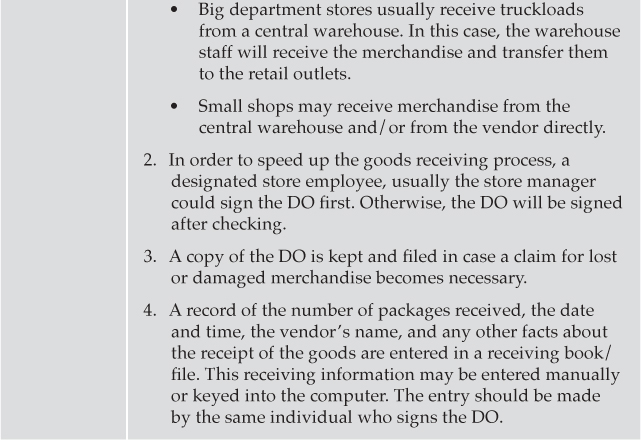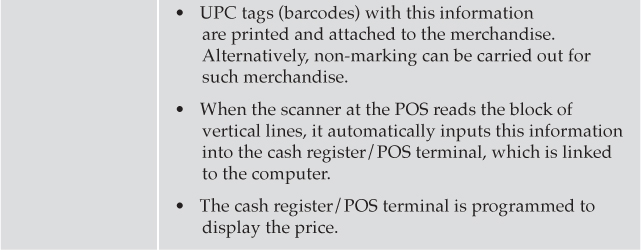Chapter 5. Stock Management

Inventory is an essential part of a retail business because it is what the shop is offering for sale to customers.
Customers expect to find the items they want when they visit the shop, and when they cannot find them, they expect the sales associate to assist them.
If the sales associate is not familiar with the stock situation and there is no proper record of the merchandise, then no sales transaction will be made. Customers will then leave the shop not having their needs met. Hence to achieve customer satisfaction, retailers have to create, maintain and monitor accurate inventory records.
This part of store operations is called stock management. Each task has to be carried out with a set of consistent procedures. Retailers have to take note of the following four aspects:
1. Area to be set aside for the task
2. Equipment available to facilitate the task
3. Documents used for verification
4. Procedures to adhere to
Ordering
Merchandise ordering is often the buyer/merchandiser’s responsibility. However, some retail shops delegate this function to the sales associates, especially for repeat orders of current products.
Merchandise ordering is an important role that carries with it great responsibilities.
Under-ordering gives rise to out-of-stock situations which result in loss of sales. On the other hand, over-ordering increases the inventory levels in the shop and when there is no sales, the merchandise will take up space in the store room and the selling floor. Rental for space is a large part of operations expenses. It is not a wise move to utilise too much shop space for merchandise that does not produce sales dollars.
Retail organisations have different procedures and rules for stock ordering. However, the following pointers are useful for any sales associate who needs to order merchandise for his shops
• Know your stock
– Check stock levels either during daily merchandise housekeeping or check the relevant sales reports. Some retailers use the computerised Point-Of-Sale (POS) System to monitor their stock levels.
– Having the right amount of stock at all times is important. Customers should not be turned away because of stock shortage. Know the minimum stock levels permitted for all the merchandise. Once the minimum stock level is reached, ordering should be carried out.
• Know your suppliers/vendors
– Find out the vendors’ fax and telephone numbers, e-mail address and the sales representatives in charge of the products. This will facilitate the ordering process.
• Be familiar with store policies on the ordering procedures
– Who is responsible for ordering new merchandise and repeat merchandise?
– How frequent can staff submit an order?
– Is there any specific day of the week or time of the day for ordering?
– Is there a specific day or time for delivery of stock by the vendors?
– Is there any limit on the quantity and value permitted to be ordered by the staff?
– Is head office endorsement required before an order can be sent to the vendors?
• Ensure sufficient time for the order to be processed and sent to the store
– Merchandise should be available at the right time. In order to ensure sufficient stock for the shop, the staff must take into consideration the lead time taken for the stock to be delivered.

Ordering Procedures

Receiving
Certain procedures are to be adhered to in receiving merchandise from suppliers. This is to ensure that the goods received are those that had been ordered, in terms of description, quantity, price and condition.

Staff receiving goods from supplier
Receiving Procedures
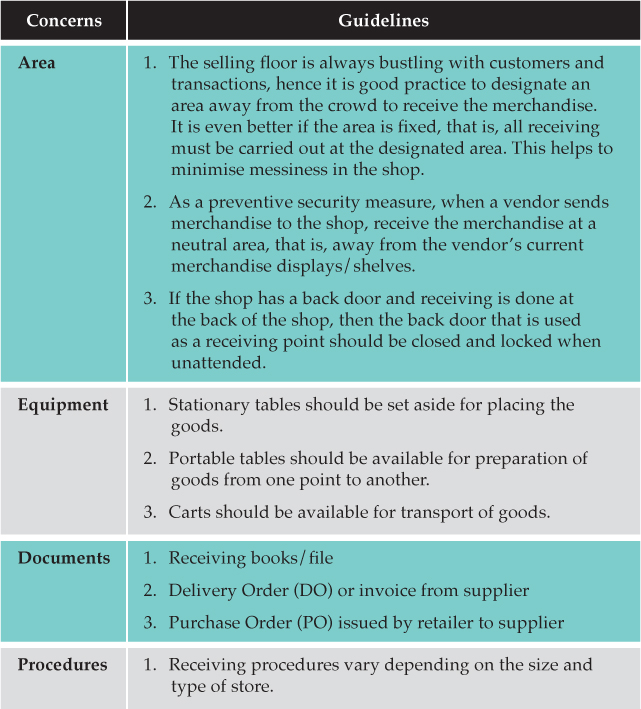
Checking
Checking the merchandise is part of the receiving procedures.

Goods received are to be checked to ensure the quality and quantity are as ordered.
Checking Procedure

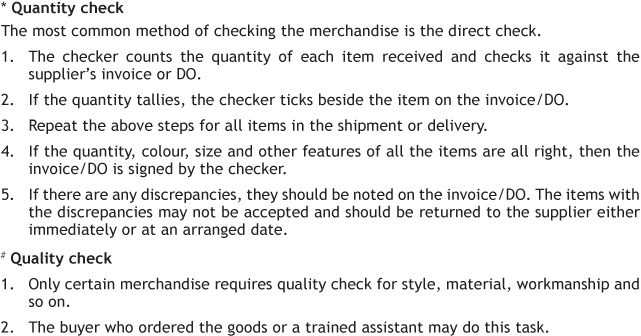
Marking/Price Tagging
Retailers want to display the merchandise for sale as soon as possible. The faster the merchandise is placed on the shelves, the faster customers can purchase the items. But first, the merchandise has to be price tagged.
Types of Marking
There are a variety of procedures for marking merchandise. Retailers have to choose the method of marking that is most appropriate for the size of their store, type of merchandise and method of operation.
There are several marking options that are available for retailers.
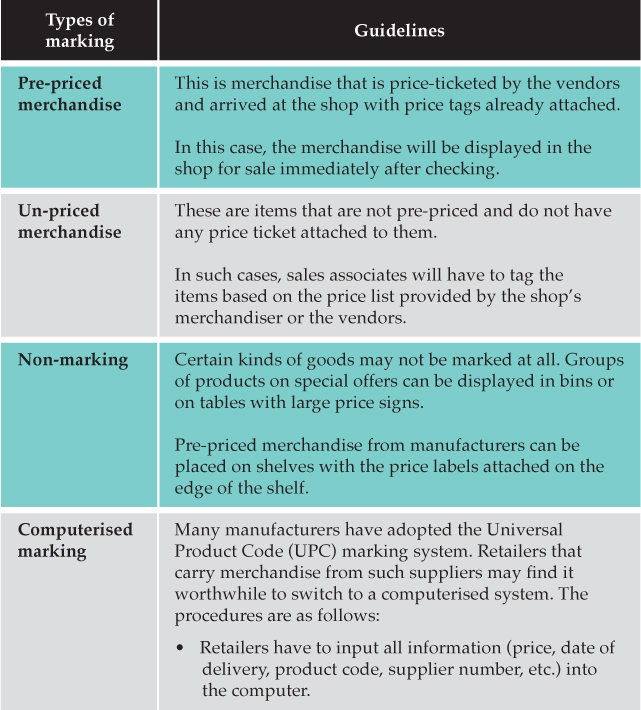
Information to Be Included on the Price Tickets
The objective of marking is to record merchandise information on the product.
This information includes:
• Price
• Product code
• Department number
• Merchandise classification such as style, colour, model, size/weight
• Supplier code
• Date of delivery/expiry
Not all of the above information needs to be included on the price tag.
There are three main considerations.
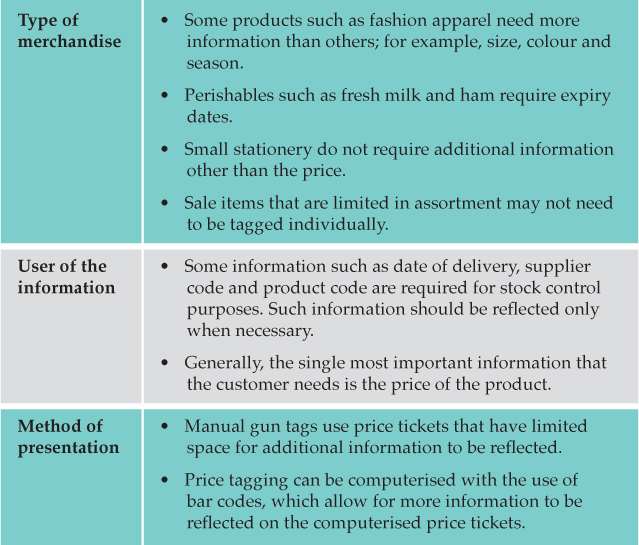
Types of Price Tickets
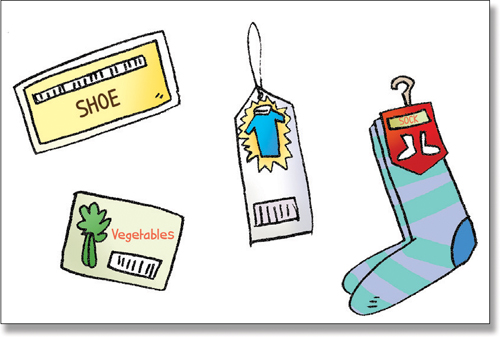
Different types of merchandise require different kinds of tickets
• Gummed labels are used for items with hard surface, such as books and appliances
• Pin tickets are used for socks and underwear
• String tags are suitable for soft merchandise like dresses, shirts and pants
Guidelines on the Placement of Price Tickets on Merchandise
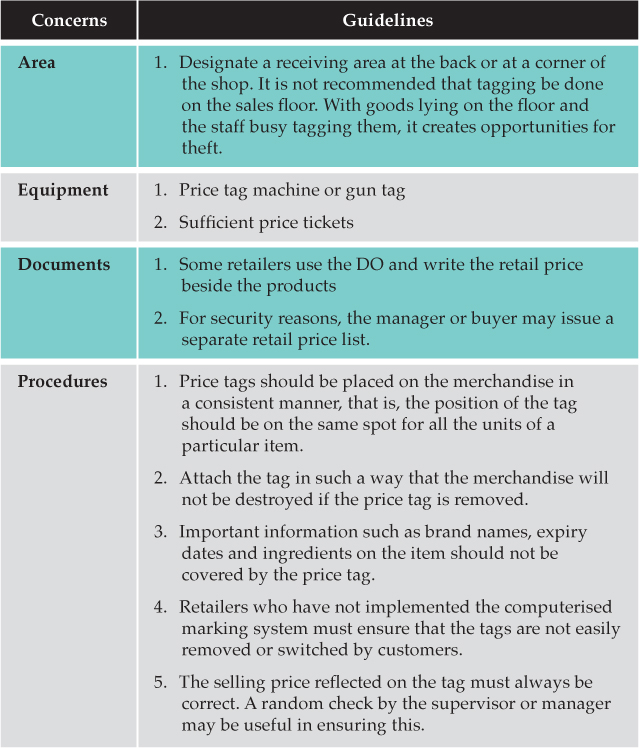
Re-Marking
Some products that are not sold at the original marked price requires the merchandise to be marked a second time. Examples are discount prices during sale periods, goods returned by customers and mark-up prices due to changes in cost price. To re-mark merchandise, retailers have to:
1. Create a new ticket and attach it to the merchandise with the original price ticket either still intact or removed.
2. Enter the new price into the computer and reprogramme the scanner computer to reflect the new price (for retailers using the UPC system).
3. Change the price signs or the price list on the shelf. Only the new price should be displayed or retailers may prefer to reflect both the old and new prices (for retailers with non-marking).
Storage
It is not possible to order the exact quantity of merchandise to be sold. A certain amount of additional stock is required for daily replenishment. In addition, more goods may be needed for seasonal peak periods such as Christmas, Chinese New Year and other festivities. Below are guidelines for merchandise storage.


Here is an example of a stock sheet:
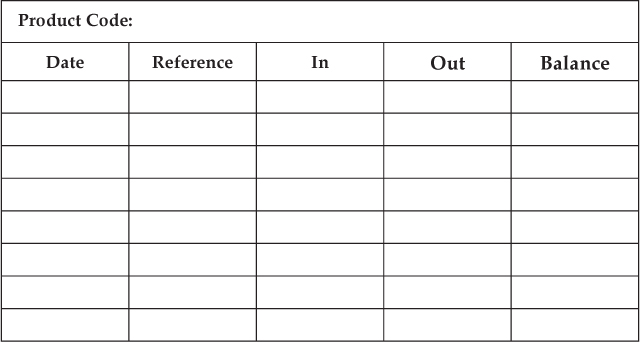
Inter-Outlet Transfers
It is necessary to transfer stocks physically from one outlet to another in a retail chain. This is especially so when a particular item in one outlet is running low in stock and the merchandise has to be transferred from another outlet that has stock.
There are basically two scenarios:
1. Transfer of stock to another outlet
2. Receiving stock from another outlet
For both, proper documentation and recording are important to ensure that every item is accounted for.
Transfer of Stock to Another Outlet
1. Sort the merchandise by code, style, colour and/or size (depending on the type of goods).
2. Pack the same item neatly in a carton or plastic bag.
3. Fill in the stock transfer form with the following information:
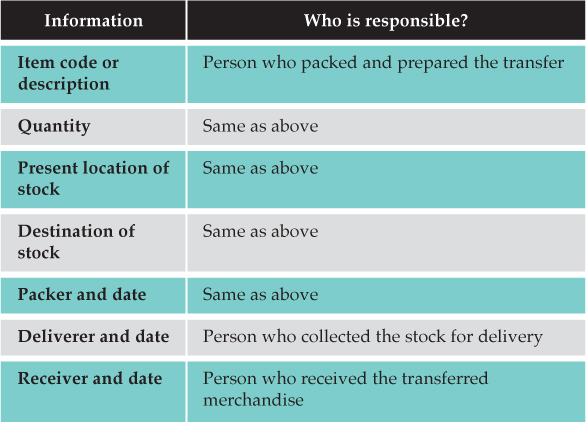
4. Attach the transfer form to the carton/bag.
5. Arrange for the stock to be delivered.
6. Once the stock is removed from the outlet, update the information in the transfer book, file or computer. The information to be updated should be similar to that stated in the transfer form.
Receiving Stock from Other Outlets
1. Check the merchandise received against that stated on the transfer form.
2. If it tallies:
• Confirm it by signing on the form (received by).
• Update the stock quantity in the outlet.
• Display or store the merchandise.
Here is an example of a transfer form:

• Contact the relevant outlet for:
– An update of its inventory record and the transfer form/file.
– Your outlet to return the excess merchandise to it.
4. If there is shortage of stock:
• Contact the relevant outlet for:
– The balance of the merchandise or an update of the transfer form/file.
– Your outlet to update the transfer form.
5. Unpack the merchandise, display and sell.
6. Update the inventory record.
Expiry and Damaged Goods Control
A shop’s profitability suffers when merchandise cannot be sold because they are damaged or the date of consumption has expired. In the worst case scenario, customers may be hurt or sick after they buy the expired or damaged products. This results in the retailers’ reputation being tarnished and even a possible lawsuit. Some items can be returned to the vendors, but more often than not, these items have to be written off.
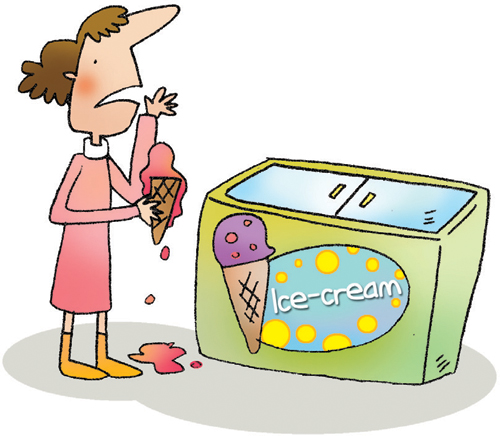
Following are some tips to monitor expired and damaged merchandise.
Identify expired and damaged stock early
• Staff should carry out random checks on the expiry dates of the goods and for damaged goods when receiving stock so as to prevent receipt of stock that have short shelf lifespan or are faulty.
Set up a schedule
• Checking can be done when conducting housekeeping on the merchandise display and shelves in the morning.
• The manager can designate a specific staff responsible for this task so as to prevent anything from being overlooked.
Returns stock
• Carry out stock returns to vendors as soon as possible.
• For perishable products like snacks and food, vendors often require sales staff to return stocks that have less than two weeks of shelf life from the expiry dates.
Returns and Claims
During the checking process, any breakage, damage, shortage, excess and even substitution of goods may be discovered.
Some retailers may not require additional paperwork for any goods returned and prefer to have an informal arrangement with the suppliers: either signing the DO first and exchanging for the correct stock on the next delivery, or returning the excess to the supplier and having the DO amended immediately. However, such an informal system with no proper record of shortage or excess may result in confusion, with merchandise that is misplaced or lost not being accounted for.
The following are guidelines for the return of merchandise to suppliers.
1. Any irregularities are to be recorded in a receiving book.
2. The person-in-charge or the supervisor should record the items to be returned on the Returns Form or the Discrepancy Report. An example of a Returns Form is shown on the next page.
3. Ensure that the item code and the quantity to be returned are correctly entered on the Returns Form.
4. State the reason(s) for the return.
5. Sign and date the form.
6. The store manager or supervisor must countersign the form.
7. Merchandise that is to be returned at a later date should be kept aside in the stockroom for security reasons.
8. When the supplier collects the merchandise, ensure that the supplier acknowledges the receipt of the returned merchandise.
9. File the original copy of the Returns Form and give the duplicate to the supplier’s personnel who collects the returned merchandise.
10. Some suppliers may request the retailers to mail the Returns Form to them.
Stocktake
Stocktaking involves the physical counting of every item in the shop and stockroom. This provides the retailer with the following advantages:
• Retailers get to know more about their merchandise, for example, saleable products, outdated merchandise or damaged goods due for return to suppliers.
• Staff are able to retrieve any misplaced merchandise.
• Stocktaking can be a time to ‘spring clean’ the shop.
• Sales personnel may also rearrange the shelf displays after the stocktake.
This exercise is usually carried out once or twice a year. The longer the interval, the less useful will be the information. To increase the accuracy of inventory control, certain areas of a store may be counted on a more regular basis such as weekly, fortnightly or monthly, with the schedule varying with the different needs of the individual retailer.
Stocktaking Procedures
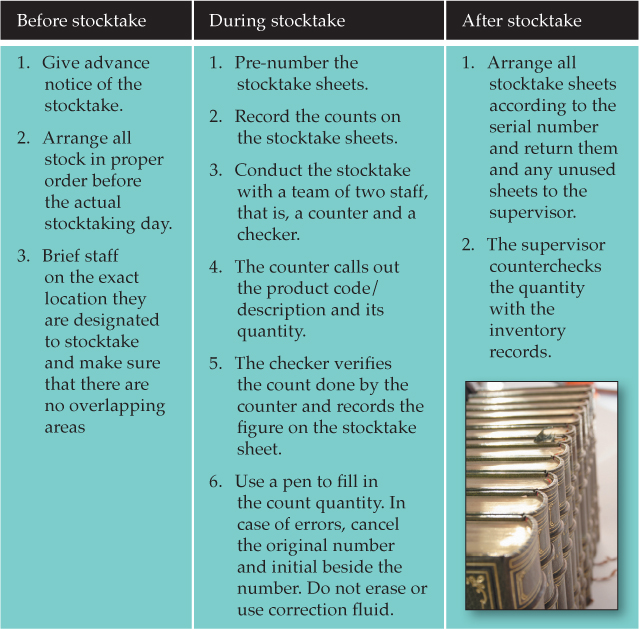
Here is an example of a stocktake sheet:
Staff Purchases
All staff purchases (including purchases by the owner) have to be monitored and recorded to ensure that there is no exploitation or abuse of benefits. The person-in-charge of the task (the owner, manager or someone designated by the retailer) has to keep a file of all these records.
The following guidelines can be used for the administration of staff purchases:
1. Create an entitlement form/card for each staff member where all purchases will be recorded.
Here is a sample of the form/card:
FRONT:
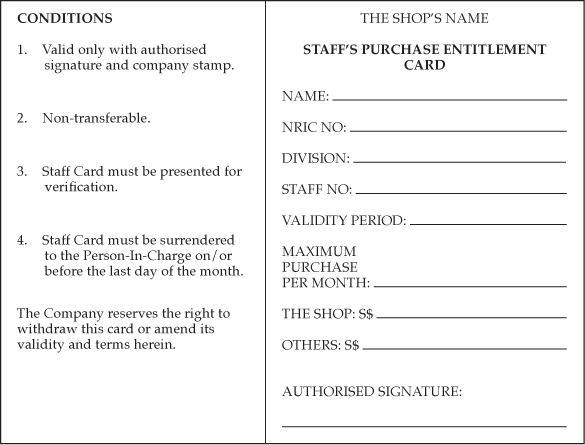
BACK:
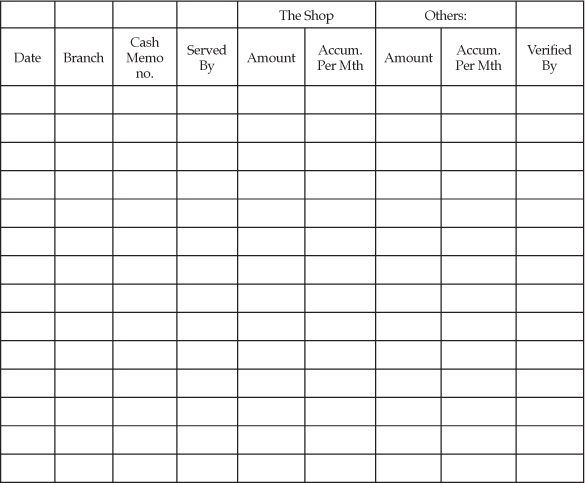
2. Determine the maximum amount of purchases allowed for each month.
3. Record each purchase in the form/card.
4. Verify the purchase. This is carried out either by the person-in-charge of staff purchases or the shop owner.
5. Staff can only pay and collect their purchases at a designated time determined by the retailer. All staff can only be allowed to claim their purchases after their shift. This is to prevent possible mix-up of staff and customer purchases.
6. Verify the payment and collection of staff purchases.
Conclusion
The procedures and processes for stock management may seem tedious and time consuming. However, with the help of information technology applications (refer to Chapter 15), many of these stock management tasks can be computerised. For example, the POS System is able to produce return notes with product information and all the sales associate needs to do is key in the quantity to be returned for each item, and to print the return notes.
Whether the retailer is using manual or computerised methods, stock management tasks are strong pillars for shop operations. It ensures accountability and minimises errors.
Do not ‘short-change’ your shop. Inventory is money!

